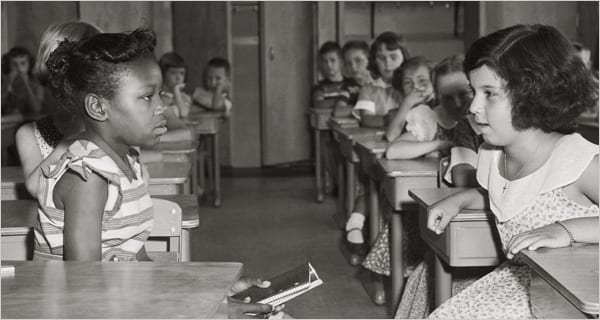It was just a simple wooden kitchen table. If I hadn’t seen the sign I might have walked past it altogether. It was a little worse for the wear, and totally ordinary, except that this table held a story. Stationed now in the Museum of American History in Washington DC, it had once belonged to the Brown family of Topeka, Kansas, and around that table, they had met night after night with the lawyers who would ultimately argue (and win) the Brown v. Board of Education case before the Supreme Court.
Oliver Brown was a welder from Topeka, Kansas. His daughter Linda was denied admission to the public school nearest to their home on the basis of her race. He and his wife chose not to accept that. And the rest, as they say, is history.

NY Times Photo: The first day of desegregation, on Sept. 8, 1954, at Fort Myer Elementary School in Fort Myer, Va.
I found myself in front of this table last week while I was visiting Washington DC for a few days with my 10 year old daughter, and the sight of it gave me pause.
I’d of course heard of the Brown v. Board of Ed case many times before, and so had my daughter, but standing before that table, just days after the murder of 9 African Americans in their historic church in Charleston, SC, brought the story into sharper focus.
I was overwhelmed by the courage it must have taken for this family and the others who joined them in the suit to pursue equal education for their children (and thereby for ALL children) in the face of unrelenting pressure, taunting, ridicule, hatred, shaming, and personal danger. Their bravery left me speechless.
A photo in this same exhibit, right next to the table, depicts a moment on that first day of integration. A young woman is exiting their car to enter her newly integrated school, but she is flanked by security guards as onlookers scowl nearby. She clearly was not being welcomed with open arms. While it may have been legally required that she be allowed to attend that school, kindness and compassion simply can’t be legislated.
I wondered how many sleepless nights the Browns endured throughout their legal battle. I wondered how many more haunted them even after their victory. I wondered if I would have had the courage to fight for my child’s right to an equal education in the face of such high personal costs. I’d like to think I would have, but the truth is that I’m not sure. Maybe it would have felt easier to protect my little ones inside our own home instead of pulling them into a public debate.
But without the brave ones willing to risk their own lives, whether literally or figuratively, by vulnerably exposing their reputations, privacy, and beliefs all for the rights of others, where would we be?
Washington DC doesn’t let you escape this message easily – each one of the sites we visited just amplified the question racing through my mind –
Consider the bravery, the courage, the stands taken by the people honored at each of these DC landmarks:
- Arlington National Cemetery
- The Lincoln Memorial
- The Martin Luther King Memorial
- The World War II Memorial
- The Vietnam Memorial
- The Korean War Memorial
- The Washington Monument
- The Holocaust Museum
If that list doesn’t stir something within you, I don’t know what will. So many sacrifices. So many people willing to take a stand.
And then, as fate would have it, at the same time we were in Washington, the Supreme Court was deliberating Obergefell v. Hodges, the title case for marriage equality. Yet another stand being taken.
We saw so much that invited thoughtful dialogue in these precious days out of our daily routine – my daughter asked well-reasoned questions and demonstrated beyond a shadow of a doubt that she has her own opinions. I’m grateful that we don’t always see things the same way. It’s important to me that she knows that’s how it’s supposed to be.
At ten, she still looks to me for permission for what she should think at times. I keep handing that permission back to her, making it clear that her opinions are her own. I’ll gladly share mine with her, or point her toward facts she can consider or perspectives she can evaluate, but only she gets to decide what she believes. And eventually she’ll also decide for what she’s willing to take a stand.
As Rav Kook, the first chief rabbi of Israel, once wrote, “Everyone must know that within them burns a candle–and that no one’s candle is identical with the candle of another, and that there is no human being without a candle. One is obligated to work hard to reveal the light of one’s candle in the public realm for the benefit of the many. One needs to ignite one’s candle and make of it a great torch to enlighten the whole world.”
That’s a call to action. A call to courage. A call to taking a stand.
Knowing what you believe takes time. But standing up for it? That takes courage.
So the question is this:
In what do you believe so deeply that you’re willing to take a stand?
Questions: Do you feel called to take a stand for something? What’s stopping you? Whom do you admire for the stand he or she has taken?